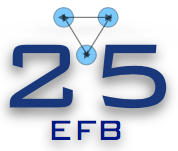Speaker
Description
The energy levels of light hypernuclei are experimentally accessible observables that contain valuable information about the poorly known interaction between hyperons and nucleons. In this contribution, I will report on our recent efforts to establish a reliable link between the low-energy properties of hypernuclei and the underlying hyperon-nucleon interactions.
In the first step, we studied light Lambda hypernuclei using the ab initio no-core shell model with realistic interactions obtained from chiral effective field theory. In particular, we quantified the precision of theoretical predictions of hypernuclear binding energies [1], as well as the lifetime of the hypertriton [2], that can be attributed to nuclear physics uncertainties. This knowledge is crucial for the use of binding energies to infer the hyperon-nucleon interaction. We studied both the convergence of the solution (method uncertainty) and the dependence on the nuclear Hamiltonian (model uncertainty). For the former, we implemented infrared correction formulas to extrapolate finite-space results to infinite model space while using Bayesian parameter estimation to quantify the resulting method uncertainties. For the latter, we employed a family of 42 realistic nuclear Hamiltonians [3] and quantified the deviation of predictions while keeping the hyperon-nucleon interaction fixed.
As a next step, we performed a global sensitivity analysis [4] of the energy spectra of light hypernuclei to identify the most influential low-energy constants in the leading-order chiral hyperon-nucleon forces [5]. For this purpose, we developed efficient and accurate emulators employing the eigenvector continuation method [6] and computed the binding energies for a wide range of the low-energy constants. We demonstrated the power of these emulators for calibration of hyperon-nucleon interaction models which has not been feasible yet due to the high computational cost.
[1] D. Gazda, T. Y. Htun, C. Forssén, Phys. Rev. C 106, 054001 (2022)
[2] A. Pérez-Obiol, D. Gazda, E. Friedman, A. Gal, Phys. Lett. B 811, 135916 (2020); D. Gazda, A. Pérez-Obiol, E. Friedman, A. Gal, EPJ Web Conf. 271, 01002 (2022)
[3] B. D. Carlsson et al., Phys. Rev. X 6, 011019 (2016)
[4] M. Sobol, Math. Comput. Simul. 55, 271 (2001)
[5] H. Polinder, J. Haidenbauer, U.-G. Meissner, Nucl. Phys. A 779, 244 (2006)
[6] D. Frame et al., Phys. Rev. Lett. 121, 032501 (2018); S. König, A. Ekström, K. Hebeler, D. Lee, A. Schwenk, Phys. Lett. B 810, 135814 (2020)

